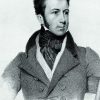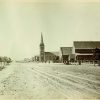For some 150 years Edward Gibbon Wakefield has confounded the city fathers of Adelaide, and some contemporary writers still don’t know how to view this most enigmatic of characters. Some gloss over his shortcomings and through a myopic prism seek only to focus on his greatest achievement: the formulation of a brilliant blueprint for systematic colonisation throughout the British Empire. Others, driven by high standards of moral propriety, take a contrary view. For them his frantic abduction of Ellen Turner under the nose of her headmistress and his persuasive prelude to their marriage at Gretna Green still rankle. A subsequent three-year jail sentence in Newgate Prison only adds to the abhorrence. Some would want to eulogise the man beyond recognition.
In South Australia, Wakefield has at various times reached heroic proportions in the minds of some. His character and style are arguably reminiscent of some of our more contemporary, outstanding political figures. However, today those who do speak his name more often do so in the context of his nuptial exploits on Gretna Green and his eventual arrest and prosecution.
Wakefield, with the complicity of his brother, servant and stepmother, hatched a devious plot to abduct and marry Ellen Turner, a wealthy 15-year-old heiress, right under her father’s and mother’s nose. This ruse was apparently quite common in the early-nineteenth century and Wakefield had history in this regard; his first wife having been the subject of an uncannily similar exploit. Indeed, there were no less than six similar elopements among members of the Wakefield clan. Apparently many a social aspirant succeeded in this kind of plot during the period. Mr William Turner – a newly wealthy county merchant who had been successful in the silk trade – was, however, not fooled by such trickery and, unlike the forgiving nature of Wakefield’s first mother-in-law, immediately sought reparation for the abduction of his daughter. The irony that Wakefield conceived his brilliant plan for systematic colonisation – the schema from which the initiative to settle a new province in South Australia sprang – while languishing in Newgate for three years as punishment for the offence is indeed remarkable.
Wakefield was to be the most difficult of students in the schools he attended where his obstinate troublemaking behaviour saw him expelled in 1812. It was not surprising when in 1816, at barely 26, he eloped with a teenager by the name of Eliza, a 17-year-old ward in Chancery. From this marriage Wakefield acquired a substantial income and two surviving children: Susan Priscilla, nicknamed Nina, was born in 1819 and Edward Jerningham Wakefield in 1820.
There was an expectation within the extended Wakefield family that Edward Gibbon should at least qualify for a profession in some way. So in 1813, with the patronage of his uncle Daniel, he was admitted to Gray’s Inn, where it was hoped he might join the legal profession. As expected, being unable to conform in any way, Edward Gibbon failed to thrive. Within a year he was on a ship to the continent, where again through family patronage he was appointed as Secretary to the Hon William Noel Hill, Britain’s envoy at the court of Turin. Further brief appointments followed with the embassy in Paris and in London. Unfortunately, his wife Eliza died soon after giving birth to their second and only surviving son.
Ironically, with his crime cruelling his chances of ever becoming a respectable politician in Britain, Wakefield did briefly become a member of a parliament some fifteen years later, (in 1842) in Canada, after working incognito with Charles Buller and Lord Durham on what is now known as the Durham Report (1839), considered to be a highly significant document on British colonial policy. Preparatory to this exercise Durham had tried vainly to have Wakefield appointed officially as Commissioner of Crown Lands in Canada. However, Prime Minister Lord Melbourne and Colonial Secretary Lord Glenelg were unrepentant in their refusal to grant the request, arguing that the government could never countenance the employment of a convicted criminal.
This type of intrigue accounts in part for the late-nineteenth century and erroneous claim that Wakefield Street was nominally attributed to Edward Gibbon’s brother, Daniel Wakefield. Those on the Street Naming Committee were mostly committed ideologues and they would have intended to memorialise Edward Gibbon despite his criminal record. However, by the late 1880s the Corporation of the City of Adelaide could not bring itself to eulogise the man, and so began a tradition to elevate Daniel Wakefield. The City of Adelaide reference books in the early part of the twentieth century referred to both brothers alphabetically, firstly Daniel and then Edward Gibbon. Subsequently, and for reasons which might be explained as sanctimonious snobbery, Edward Gibbon’s name was dropped in subsequent attributions. The people of Adelaide have been misled ever since. Ged Martin highlights the issue by explaining that ‘the extent of Wakefield’s influence in the [whole colonisation] scheme is hard to assess, largely because as an ex-convict he was kept in the background’.
Given the close contact and written correspondence that some on the Street Naming Committee had with Wakefield from Adelaide, especially John Brown – the Emigration Agent – and the fact that Wakefield’s brother Daniel had been rejected for a position by the South Australian Colonization Commission, there is little doubt that such a prominent street name was named after E G Wakefield. Evidence in Brown’s diary is more supportive of Edward Gibbon than his less famous brother. On the evening before the departure of the Africaine, E G Wakefield threw a huge party for all who might come. Brown’s entry reads:
June 1st 1836: Party at WAKEFIELD’S in the evening. Gouger not there, and has written a stiff formal letter declining the “honour”. It is unwise to keep up this ill feeling when on the point of quitting England perhaps forever, and when the interests of the Colony are perhaps concerned … Wakefield’s party was numerous and very handsomely entertained. Hutt, Pennington, the commissioners, were there … and lots of colonists. EGW and not his brother. EGW was back in town and full of himself.
The fact that the east/west axis of the city of Adelaide includes someone as prominent as Grote strengthens this point further. Both Grote and Wakefield streets were considered almost as sacrosanct as King William Street. As late as the 1870s Wakefield was still remembered favourably, and those who were still alive and who could remember how the project was conceived were lobbying for a statue of him somewhere in greater Adelaide.
Edward Gibbon Wakefield was portrayed as a man of upright arrogance, indeed pomposity. However, he came to be regarded as a ‘thinking man’ who formed a loyal core of supporters including Sir William Molesworth, William and John Hutt and other eminent political characters.
When the South Australian Company ships HMS Buffalo, the Africaine and several other ships departed in 1836 once the South Australia experiment was underway, Wakefield was not aboard any of them. He was still grieving the untimely death of his teenage daughter, Nina. He had fallen out with Robert Gouger and to a lesser extent with the commissioners for disregarding ‘his model’: they had dropped the price of each acre in the colony to twelve shillings. Wakefield was outraged! Didn’t they know and understand that the whole scheme depended on land being charged at ‘a sufficient price’? For a time he accused some of the members of the South Australian Association of being Tories. However, by the time of departure he had reconciled with all but Gouger and was appointed as Emigration Agent in London.
Restless as ever Wakefield pressed on with further attempts to initiate colonising schemes wherever he had tangible support. He returned to Canada in 1841, this time as an entrepreneur on behalf of the North American Colonial Association of Ireland and its intention of settling emigrants. He invested energy into the New Zealand colonisation experiment in Canterbury, arriving in 1852. Given that in midlife he was described as a corpulent man with a florid complexion who sat to the richest foods and the best cigars and whisky, a high blood pressure event was afoot.
Presumably the reputed £20,000 Wakefield was supposed to have extracted from his role in Canada catapulted him into the high life. After prompting from John Stuart Mill to outline his colonisation theory in detail, he finally found time to complete his last great work A view of the art of colonization (1849).
As Wakefield slowly recovered he began to take interest in emigrating to New Zealand. The passage of the New Zealand Constitution Act 1852 provided for the election of what were called Provincial Councils, and with the prospect of a parliamentary career in the colonies he set sail for Canterbury. He arrived in Christchurch in 1853. Shortly thereafter he moved to Wellington, where he was elected to the seat of Hutt in the first New Zealand General Assembly. However, his health continued to deteriorate and he spent his last years out of the public eye, living in seclusion in Wellington. He died on 16 May 1862, almost penniless, his total estate worth less than £500.






Comments